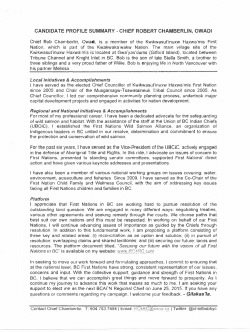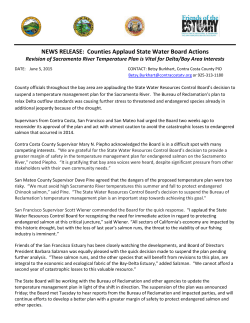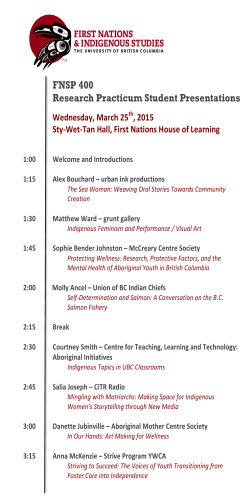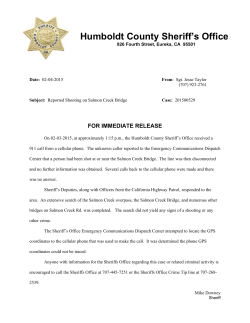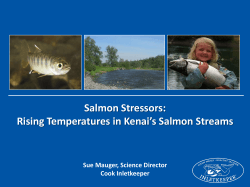
2015 Submission to the Ministerial Advisory Committee on Atlantic
P.O. Box 377, Kensington, PEI C0B 1M0 www.peiwatershedalliance.org ____________________________________________________________________________ Submission to the Ministerial Advisory Committee on Atlantic Salmon May 7, 2015 We applaud the Hon. Minister of Fisheries and Oceans for creating the Ministerial Advisory Committee on Atlantic Salmon. It is our hope that the Ministerial Advisory Committee is successful in determining the best course of action required to improve Atlantic salmon abundance throughout the North Atlantic. Atlantic salmon are a symbol of a healthy environment and the presence of this iconic species resonates with all Canadians. Given the life history of this magnificent species, it is imperative we identify and act upon common goals that benefit wild Atlantic salmon. The seriousness of the decline in this species cannot be understated. Accordingly, we welcome this opportunity to present some of our views on the status of wild Atlantic salmon on Prince Edward Island. PEI is well known as a trout-rich Province, but often disregarded for Atlantic salmon. Historical accounts indicated Atlantic salmon occurred throughout PEI with an estimated 71 rivers containing habitat suitable for salmon (Cairns et al, 2010). Original salmon populations of PEI were dominated by late-run, multi-sea winter (MSW) fish. Today, Atlantic salmon are only found in twenty-two streams on PEI, many of which have populations at precariously low levels with only a few Island rivers meeting conservation requirements (Guignion, 2009). Atlantic salmon on PEI are negatively affected by multiple issues related to land use, but the primary ones are sedimentation, fish passage and pesticide-related fish kills. The impacts of intensive agricultural land use on PEI’s environment are well known (Cairns, 2002). Exploitation of Atlantic salmon through angling, poaching and First Nation harvest is thought to be very low. Fish stocking of salmon smolts via semi-natural rearing was the basis for the summer salmon angling in the 1990’s in a few select rivers on PEI large enough to support salmon angling. In recent years the stocking of salmon smolts was curtailed when the Department of Fisheries and Oceans (DFO) eliminated support for Federal fish hatcheries. It is believed wild Atlantic salmon stocks continue to decline on Prince Edward Island, and without drastic intervention, fewer rivers will be home to Atlantic salmon in the future. An exception to this decline is in the Northeast portion of PEI, where increasing numbers of Atlantic salmon redds have been counted since 2008 and the number of salmon rivers has increased from four to seven. The Committee on the Status of Endangered Wildlife in Canada (COSEWIC) has included PEI in a designatable unit that includes the southern Gulf of St. Lawrence and the Gaspé Peninsula. Atlantic salmon within this area have been assessed as a species of Special Concern. However, COSEWIC (2010) has recognized that conservation status of Atlantic salmon varied within this designatable unit, and noted particular conservation issues on PEI that arise from poor habitat quality (Cairns et al, 2012). Recent research by the Laval University identified a different genetic cluster of Atlantic salmon in two rivers within the Northeast portion of PEI when compared to other Gulf of St. Lawrence populations. This suggests that PEI had a different genetic group prior to stocking (Moore et al., 2014). Implications of this “ancestral” strain of Atlantic salmon include the potential for different life histories, including migration routes. This might be an explanation for why some populations of salmon are increasing on PEI. However, this research also highlights how little is known about Island salmon stocks and about small salmon rivers in general. The issue of exploitation at-sea is the number one issue facing Atlantic salmon throughout the North Atlantic. Understanding at sea mortality remains one of the bigger mysteries for Atlantic salmon. Research efforts should be increased to better understand the marine phase of the Atlantic salmon life cycle. We recommend DFO assign more importance to this area of Atlantic salmon research and commit more resources. Targeted high-seas harvest of Atlantic salmon is likely having significant impacts throughout the North Atlantic. We do not fully understand the extent of the harvest, but it has been reported in a number of sources to be increasing. Clearly, this issue needs to be addressed and the Atlantic Salmon Federation (ASF) and their grass-roots affiliates can only do so much. We feel this issue needs strong leadership and diplomacy to resolve, and clearly the Government of Canada bears considerable responsibility to find solutions. Atlantic salmon by-catch in commercial fishing operations remains a problem in PEI coastal waters. There is uncertainty as to whether or not these salmon are destined for PEI rivers; nonetheless this is a conservation issue for the region. We recommend DFO step up efforts to regularly visit commercial fishing operations as a deterrent to the exploitation of wild Atlantic salmon. We are aware of some Island watersheds where salmon populations are barely hanging on, yet we hear reports of MSW salmon being exploited in the summer and fall from commercial fishing operations. By-catch of any Atlantic salmon is a conservation issue. For PEI, given the small size of our rivers and the small production units contained therein, every fish is important, regardless of life history stage. Efforts to address sedimentation have been met with some success, but the nature of PEI soils and cultivation practices leave us very vulnerable to excessive soil losses from agricultural lands at certain times of the year. The chronic issue of fish kills on PEI has also not gone unnoticed by the public or the agricultural community. Watersheds that have a high proportion of land in potato production are also most at risk for a pesticide-related fish kill. A provincial government Action Committee has been developed with industry to find opportunities to reduce the likelihood of future pesticide-related fish kill events. Accordingly, the risk will always be present as long as the chemical inputs for successful crop production remain. Barriers to fish passage remain a serious problem on PEI, and this has been well articulated in the document A Conservation Strategy for Atlantic Salmon in Prince Edward Island (Guignion, 2009). Impoundments, road crossings and beaver dams all reduce the mobility of both juvenile and adult Atlantic salmon and more needs to be done to ensure the species has unrestricted access to its preferred habitats. Perhaps unique to PEI, the impact from beaver dams on anadromous fish remains more serious since it is underscored by small watersheds where beaver dams can remain intact, even under flood flow conditions. Beaver dams and impoundments on PEI also contribute to elevated summer water temperatures which are only expected to get worse under a warming climate. We are concerned about recent and ongoing ecosystem changes. Predators such as striped bass, seals and double-crested cormorants are species that have greatly increased in recent years that are likely reducing the survival of Atlantic salmon. It may be prudent to consider allowing greater harvest of striped bass via recreational angling. Furthermore, it may also be warranted to allow some form of deterrence to cormorants as they are major predators of juvenile salmon and cormorant populations have been increasing for some time on PEI. While we are generally not supportive of predator management that favors species-specific conservation goals, immediate measures need to be taken to address further declines in Atlantic salmon populations. Recreational fly fishing opportunities for Atlantic salmon on PEI are almost non-existent now as many rivers previously open in the fall season have been closed by DFO for conservation measures. The only exception would be the Morell River where a fall salmon season remains in place. We view the removal of salmon anglers from rivers as a major challenge in community engagement and local conservation efforts. Shutting down rivers to angling is not the answer, especially considering salmon angling has been live release for some time. Strong participation in fly fishing is key to the future of Atlantic salmon. Regrettably, the closing of recreational fishing seasons for Atlantic salmon appears to be happening in other parts of the Maritimes. Recreational salmon fishery closures will invariably result in the loss of the long-standing tradition of salmon angling and reduced interest in grass-roots conservation initiatives. We feel the latter is already occurring. Community-based watershed groups are integral in the stewardship of the salmon resource. Watershed groups require increased support from all levels of government to continue improving fish habitat and engaging local landowners. This support needs to be more consistent so organizations are able to effectively plan at the grass-roots level rather than the year-to-year juggling currently practiced. It would be very helpful to have improved access to technical support from scientists involved in the study of Atlantic salmon. We are particularly concerned that the assessment of salmon stock abundance on PEI is thought to have a high level of uncertainty (Cairns, et al, 2012). In closing, we wish the advisory committee all the best in their deliberations to recommend measures to improve the status of wild Atlantic salmon. We hope that our submission and those of other conservation organizations result in meaningful actions to reverse the decline in Atlantic salmon abundance throughout the North Atlantic. Summary of Recommendations: 1. The Department of Fisheries and Oceans need to re-affirm their mandate for the conservation of wild Atlantic salmon. 2. More Atlantic salmon research is required to better understand mortality issues in the marine environment. 3. Improved diplomacy and communication efforts need to be fully exercised to find solutions to drastically curtail the exploitation of Atlantic salmon at-sea. 4. Island watershed groups need more technical and financial support to carry out restoration projects that maximize salmon production in freshwater. 5. Significant reductions in sedimentation are required in PEI watersheds under the most intensive agricultural pressure. 6. More scientific expertise is needed, particularly in the area of stock assessment. 7. Increased research on the PEI ancestral strain of Atlantic salmon, particularly life histories and migration routes. 8. Options for reducing the abundance of predators to Atlantic salmon should be more fully considered. Examples where this may be appropriate and feasible would include double crested cormorants, seals and striped bass. 9. By-catch of Atlantic salmon remains an issue in PEI coastal waters. Enforcement personnel need to be vigilant in stepping up efforts to provide a deterrent. 10. The Department of Fisheries and Oceans need to improve their delivery of funding programs for the conservation of Atlantic salmon and aquatic habitat. An example of this is DFO’s Recreational Fisheries Conservation Partnerships Program (RFCPP) which many Island watershed groups no longer apply for given their experience with administrative hurdles. References Cairns, D.K., MacFarlane, R.E., Guignion, D.L., and Dupuis, T. 2012. The status of Atlantic salmon (Salmo salar) on Prince Edward Island (SFA 17) in 2011. DFO Can. Sci. Advis. Sec. Res. Doc. 2012/090. iv + 33 p. Cairns, D.K. (Ed.). 2002. Effects of land use practices on fish, shellfish, and their habitats on Prince Edward Island. Can. Tech. Rep. Fish. Aquat. Sci. No. 2408. iv + 157 p. Guignion, D., 2009. A conservation strategy for Atlantic salmon in Prince Edward Island.University of Prince Edward Island & Oak Meadows Inc. Moore, J-S., Bourret, V., Dionne, M., Bradburry, I., O’Reilly, P., Kent, M., Chaput, G., and Bernatchez, L. 2014. Conservation genomics of anadromous Atlantic salmon across its North American range: outlier loci identify the same patterns of population structure as neutral loci. Mol. Ecol. 23: 5680-97.
© Copyright 2026


